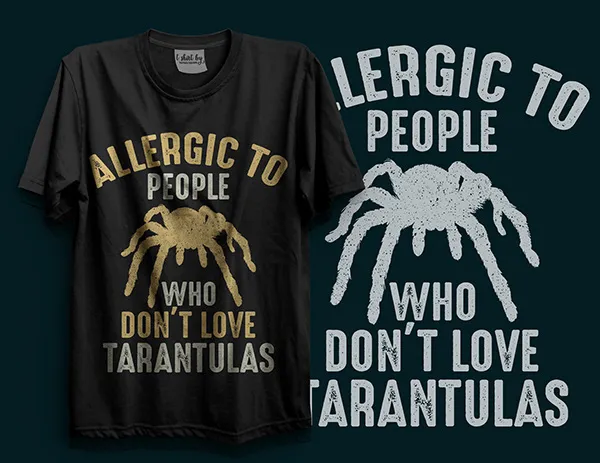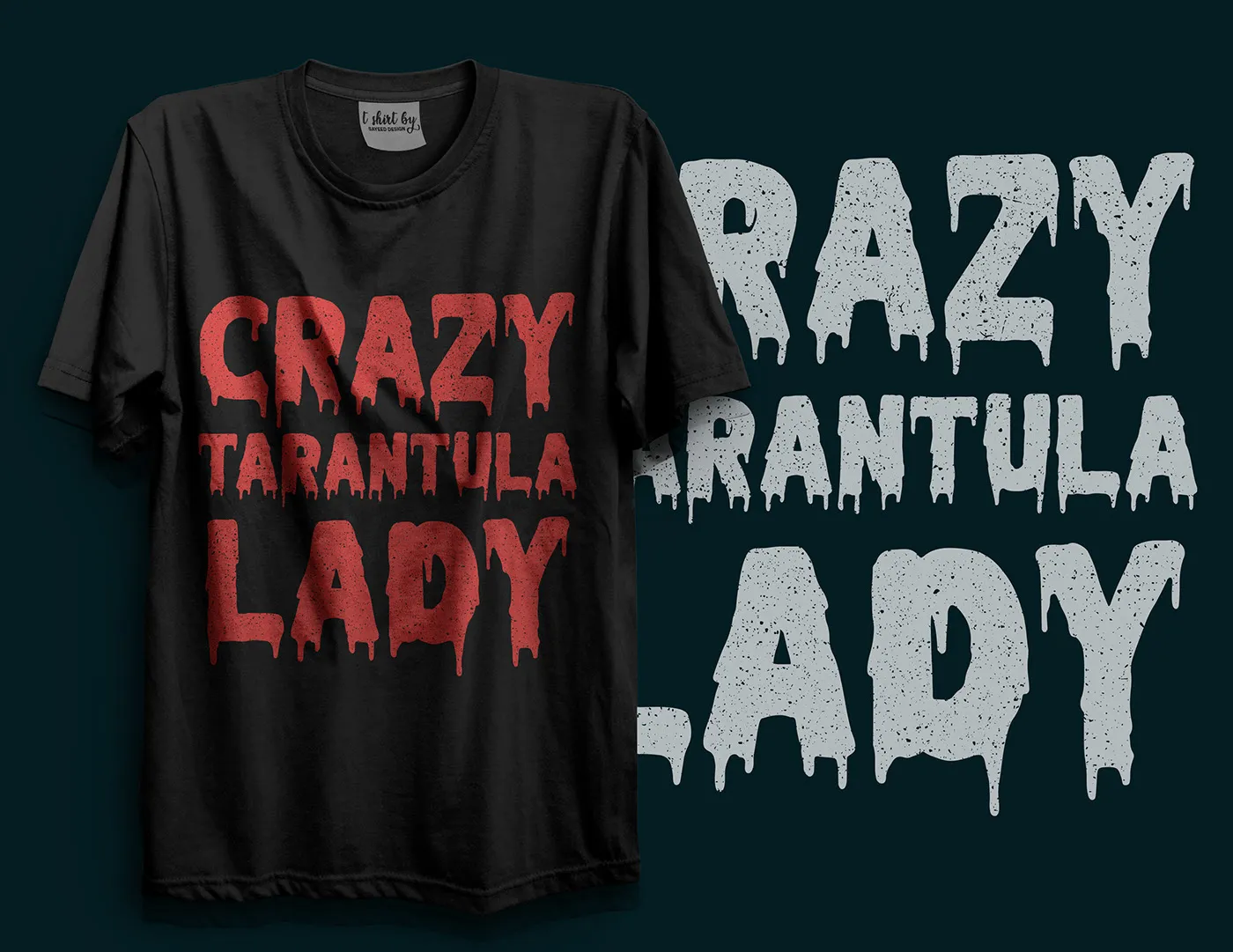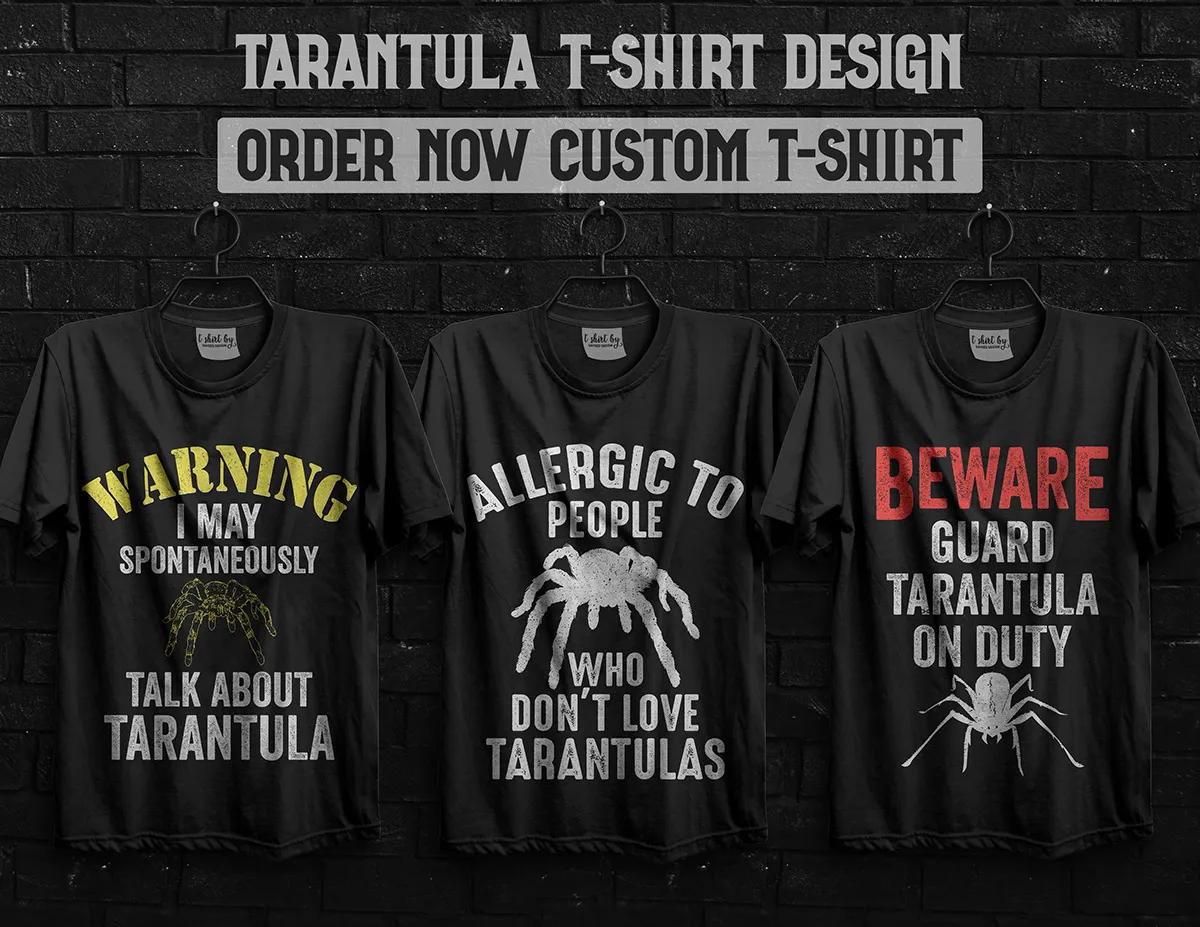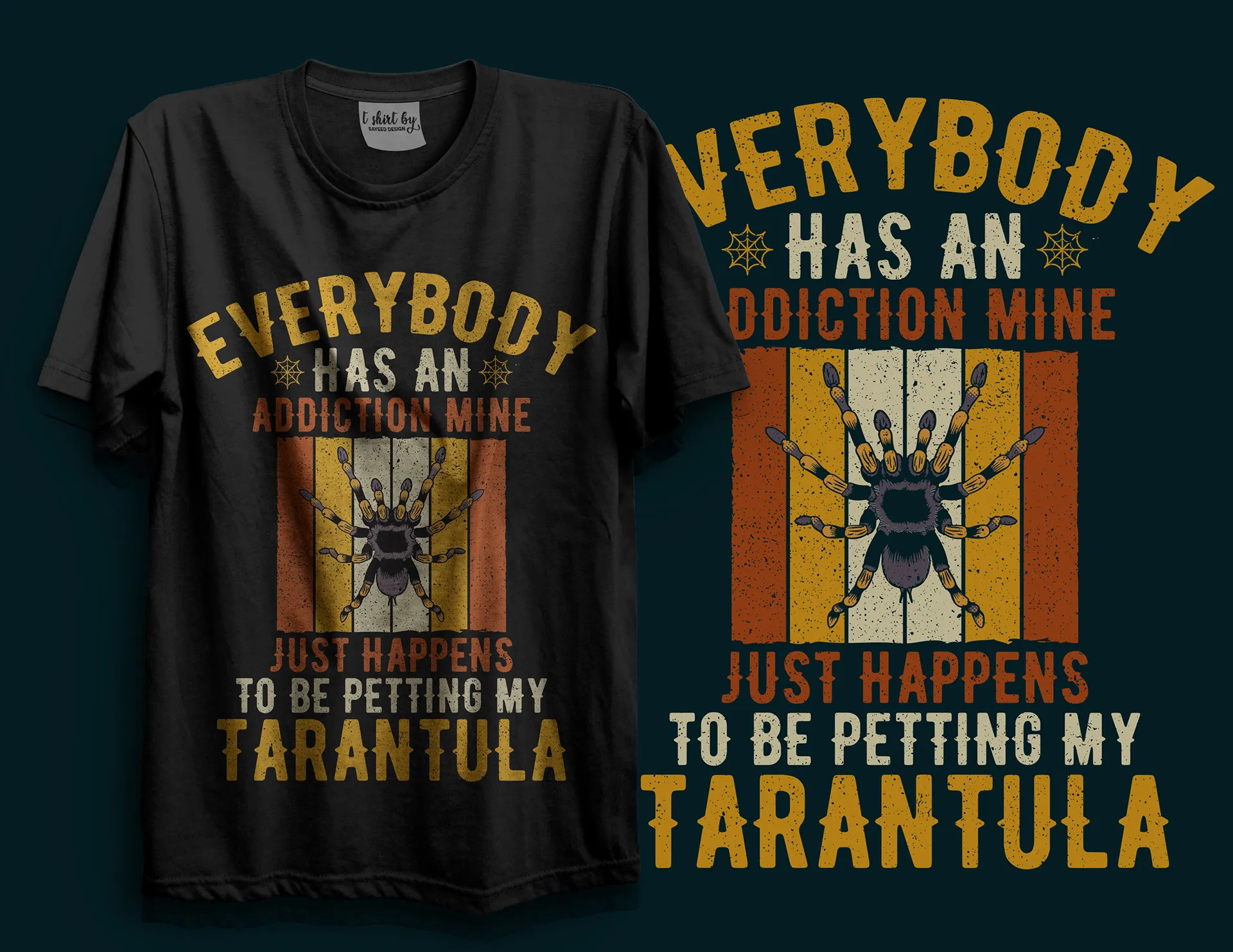Understanding the Tarantula T-Shirt Logo Design
Designing a tarantula t-shirt logo is more than just creating an image; it’s about crafting a visual representation that embodies the essence of the brand or message. The logo serves as the first point of contact for potential customers, conveying information about the t-shirt’s style, the target audience, and the overall feel. A well-designed logo is memorable, versatile, and speaks volumes about the product. It should be easily recognizable and effectively communicate the intended message, whether it’s about the unique characteristics of the tarantula itself or a broader theme associated with it. The t-shirt logo, therefore, sets the stage for the overall impression and appeal of the garment.
The Significance of a Tarantula Logo
A tarantula logo carries significant weight in branding a t-shirt. It’s not merely decorative; it acts as a powerful tool for brand recognition. A compelling logo grabs attention, making the t-shirt more appealing and memorable to potential buyers. This recognition can build customer loyalty, as people begin to associate the logo with a specific quality or style. For a tarantula-themed t-shirt, the logo design is especially critical. It can convey a sense of mystery, nature, or even a niche interest, like insect enthusiasts. The logo also aids in distinguishing the t-shirt from competitors, making it stand out in a crowded market. Essentially, a well-crafted tarantula logo is an investment in the t-shirt’s success, building brand awareness and driving sales.
Essential Elements of a Great Tarantula Logo

Several key elements contribute to the effectiveness of a tarantula logo. Simplicity is vital for memorability and versatility; a complex design can be hard to remember and may not scale well for various uses. The logo should be unique, avoiding generic imagery to stand out. It should be easily recognizable even when reduced in size or used in different contexts. Consider the use of appropriate typography; the font should complement the tarantula image and overall theme, ensuring readability. Furthermore, the color palette plays a critical role, impacting the logo’s emotional resonance. Colors should be selected carefully to align with the t-shirt’s brand and target audience. Finally, the design must be adaptable, functioning well on different t-shirt colors and materials.
Choosing Your Design Style
The design style significantly impacts a tarantula t-shirt logo’s overall appearance and message. The chosen style should reflect the brand’s personality and the desired impression on the target audience. A realistic design style can create an authentic and detailed image of a tarantula, appealing to enthusiasts who appreciate precision and accuracy. A more stylized approach, however, might opt for a simplified or abstract representation of the spider, which could be more versatile and easily adaptable to different branding needs. Selecting the appropriate design style, therefore, is crucial for effectively communicating the intended message and capturing the attention of the desired audience. This choice is fundamental to the logo’s success and overall impact.
Realistic or Stylized
The choice between a realistic or stylized tarantula design depends on the brand’s goals. Realistic designs offer detail and accuracy, appealing to an audience that values precision and authenticity. These logos often showcase the tarantula in a lifelike manner, with detailed features and textures. Stylized designs, on the other hand, use simplified forms, potentially incorporating geometric shapes or abstract representations of the tarantula. They are versatile and can be adapted to various uses. The decision depends on the intended message. A realistic logo might be chosen to educate or highlight specific features of the tarantula, while a stylized version might be used to represent a broader theme or brand identity. Each style serves different purposes in the context of t-shirt branding.
Minimalist or Detailed

Deciding between a minimalist or detailed approach is another critical aspect of tarantula logo design. Minimalist designs focus on simplicity, employing only the essential elements to convey the message. This approach enhances memorability and versatility, making the logo easily recognizable across various platforms and sizes. The minimalist approach often uses clean lines, negative space, and a limited color palette. Detailed designs, however, incorporate more elements, textures, and intricate features. This approach can allow for more detailed representations of the tarantula and related themes, but it may compromise versatility and memorability. The selection depends on the target audience and the brand’s objectives. Simplicity often works well for modern branding, while detail can be effective for certain niches, such as scientific or educational purposes.
Colors and Fonts for Your Tarantula Logo
Colors and fonts play a significant role in defining the visual impact and message of a tarantula t-shirt logo. The color palette should reflect the tarantula’s natural habitat or the brand’s identity. Earth tones like browns, greens, and blacks can create a sense of nature and mystery, while brighter colors could be used for a more modern or playful aesthetic. The choice of font is equally important. The font should complement the image of the tarantula, conveying the brand’s personality and ensuring readability. Consider both the font style and weight; a bold font might be used for impact, whereas a lighter one would offer a more elegant touch. Together, colors and fonts create visual harmony and communicate the desired mood, helping to make the logo memorable and effective.
Color Psychology in Logo Design
Understanding color psychology is essential when designing a tarantula logo. Colors evoke specific emotions and associations, shaping how viewers perceive a brand. For a tarantula-themed logo, the color choices can be highly impactful. For instance, black often symbolizes mystery and sophistication, making it suitable for brands that emphasize the unique aspects of the tarantula. Brown hues connect the brand with nature and earthiness. Greens can represent growth and a natural environment. The selected color palette should align with the t-shirt’s target audience. The use of bold and bright colors can create a playful or youthful appearance, while muted tones tend to reflect a sense of sophistication or seriousness. Understanding how colors influence perceptions helps in creating a compelling and effective logo.
Font Selection for Visual Appeal

Font selection is a critical aspect of tarantula logo design. The font should complement the tarantula illustration and reflect the brand’s overall style. Consider whether the font is serif or sans-serif; serifs offer a classic feel, while sans-serif fonts appear modern and clean. The font’s weight and style also influence how it is perceived. A bold font can project strength and confidence, while a more delicate font may create a sense of elegance. The font must be readable at various sizes, especially on a t-shirt. Consider the kerning, or spacing between letters, for visual balance. The choice of font should align with the brand’s target audience and desired image. It is always important to ensure that the font does not clash with the tarantula image. A well-chosen font improves visual appeal and ensures the logo’s message is clearly communicated.
Designing the Tarantula Illustration
The tarantula illustration forms the core of the logo, so it must be designed carefully. Researching the species, its features, and its overall appearance is essential. Start with sketches to explore different poses, perspectives, and styles. Consider the tarantula’s key characteristics: the hairy legs, the body shape, and the fangs. Decide whether to depict the tarantula realistically or in a more stylized manner. The illustration must be easily recognizable and memorable. The details should be simplified for a t-shirt design to ensure that the logo is visible when printed. Focus on the essential elements that define a tarantula. Make the illustration eye-catching and appropriate for the target audience. The visual must communicate the brand’s message and resonate with potential customers.
Sketching and Concept Development
Sketching is a fundamental step in designing a tarantula logo. Begin by sketching different concepts, exploring various poses and compositions for the tarantula. Experiment with different design styles, from realistic portrayals to more stylized or abstract representations. These initial sketches serve as a foundation for the final design. Don’t be afraid to try various ideas. Focus on creating a unique and visually compelling image. Consider the placement of the tarantula, the overall layout, and the potential use of negative space. During this phase, it is important to gather inspiration from other logos, tarantula images, and related themes. Develop multiple sketches, refining your best ideas and exploring variations. Sketching helps you refine your concepts and choose the most effective design for your t-shirt logo.
Digital Design Tools and Software

Digital design tools and software greatly enhance the creation of a tarantula logo. Vector-based programs, such as Adobe Illustrator, are ideal for logo design due to their scalability without loss of quality. Raster-based programs like Adobe Photoshop can be used to add detail or texture to the illustration. Familiarize yourself with the chosen software’s features, including drawing tools, color palettes, and typography options. The digital design stage involves refining the sketches, adjusting the colors, and creating a polished, professional design. Take advantage of the tools to experiment with different elements, such as gradients, shadows, and textures. Using digital tools, one can create multiple variations of the logo, evaluate its appearance on mockups, and prepare the design for printing on t-shirts.
Logo Variations and Mockups
Creating logo variations and mockups is essential for evaluating the effectiveness of the tarantula logo. Develop different versions of the logo, including variations in color, size, and layout. These variations ensure that the logo functions well across multiple applications, such as on different t-shirt colors, in various sizes, and across different media. Mockups are invaluable for visualizing the logo on a t-shirt, giving a realistic view of how it appears on the garment. Use mockup templates to see the logo on various t-shirt styles and colors, allowing you to make necessary adjustments. Evaluate the logo’s visual impact and readability from different perspectives. This step is fundamental in fine-tuning the design and ensuring the logo looks great in real-world applications.
Testing and Refining Your Logo
Testing and refining your tarantula logo is essential for its success. Conduct usability tests to assess how well the logo is understood by potential customers. Display the logo to various individuals and gather feedback on its visual appeal, memorability, and clarity. Ask for opinions on the logo’s overall message and how it relates to the brand or t-shirt’s theme. Identify any areas for improvement based on the feedback. Refine the design based on the testing results. This could include adjustments to colors, fonts, or the tarantula illustration itself. Iterate on the design until the logo meets the criteria of effectiveness and aligns with the intended brand identity. Proper testing and refinement are critical to ensuring that the final tarantula logo is impactful and well-received.
Gathering Feedback

Gathering feedback is a key step in refining the tarantula logo. Seek opinions from a diverse group, including potential customers, design professionals, and brand experts. Present different variations of the logo and ask for their impressions. Ask them to describe what they see and what emotions it evokes. Determine if the logo communicates the intended message clearly and if it stands out from the competition. Use the feedback to identify areas for improvement in the design. Address any confusion or negative reactions. Be open to constructive criticism and willing to revise the logo based on the gathered insights. The feedback should provide a clear view of the design’s strengths and weaknesses. The goal is to ensure that the final logo resonates with the target audience and conveys the desired message.
Finalizing Your T-Shirt Tarantula Logo
Finalizing the tarantula logo is the last step in the design process. Based on the gathered feedback and testing, make any final adjustments to the design. Ensure that the logo is optimized for use on t-shirts, taking into consideration printing techniques and fabric types. Choose the correct file formats for the final logo, typically vector files (such as AI or EPS) for scalability and raster files (such as PNG or JPG) for web use. Create a style guide or branding guidelines to maintain consistency when using the logo. This guide includes the approved color palette, font specifications, and usage guidelines. Ensure the logo is versatile and adaptable for various applications and future needs. With a finalized logo, you are now ready to integrate it into your brand and t-shirt designs, ensuring a professional and consistent brand identity.
